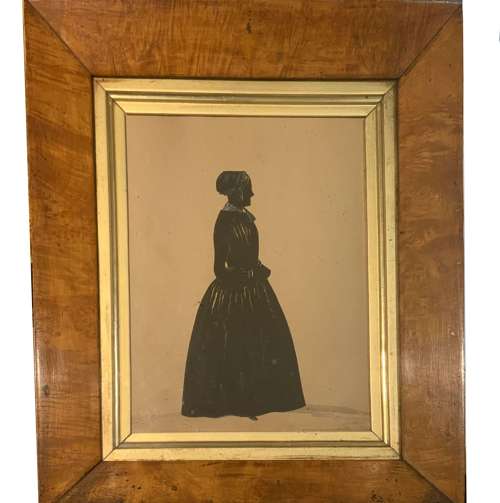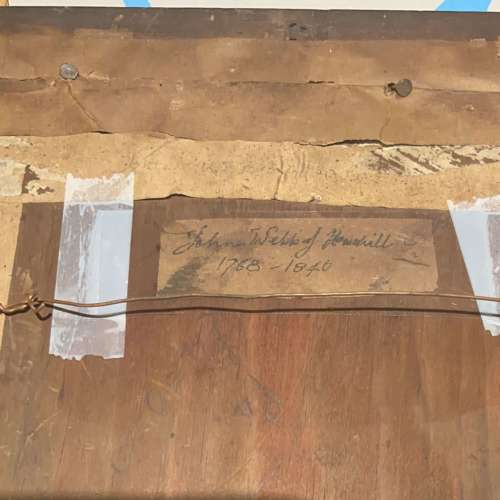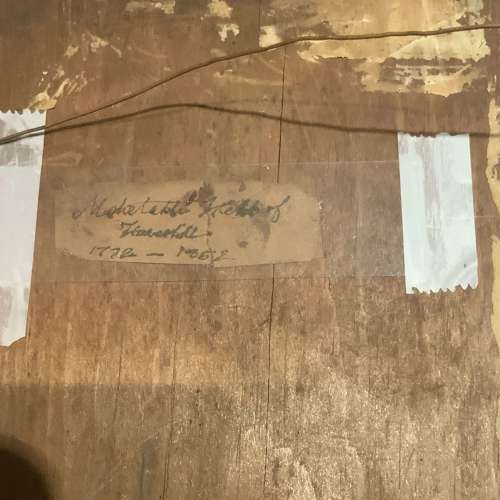Mehetable & John Webb “Poet of Haverhill” Pair C.19th Silhouettes
Delivery Quote Request
Please fill in the form below to request a delivery quote from Tregeagle Fine Art.
Contact Tregeagle Fine Art
 Oxfordshire, United Kingdom
Oxfordshire, United Kingdom
Simply fill in the below form to get in touch with Tregeagle Fine Art regarding this item.
About this item
"John Webb" (1768-1840) 'The Weaver Poet' of Haverhill, Suffolk & his wife "Mehetable Webb" (1772-1852)
A pair of miniature portrait silhouettes
Watercolour with white bodycolour and gilt highlights on card
English School
Circa 1830
Measure (Each):-
24 cm high x 18 cm wide (image)
37 cm x 30.5 cm (framed)
Provenance:-
Private collection East Anglia (Essex/Suffolk Border)
A fascinating pair of late Georgian miniature portrait silhouettes of the "Weaver Poet" John Webb and his wife Mehetable [1], retaining their original maple frames with gilt slips. Old labels verso confirming the names and dates of the sitters.
John Webb (1768-1840) was a Suffolk-born, non-conformist weaver and a poet. He married Mehetable Webb (née Browne) (1772-1852) in about 1796. They had at least eight children (the eldest of whom was born in 1797). The images here date to around 1830 and so the sitters were, respectively, in their late 50s/early 60s - which is consistent with their appearances.
In 1785 John Webb had submitted a poem to Wit’s Magazine for a prize competition, although he did not win he was inspired to keep writing and had his first poem published in the Lady’s Magazine in 1792. Like his fellow Suffolk-born countryman the 'Rural Bard' Robert Bloomfield (1766–1823), almost his exact contemporary, Webb stressed his rural background in his case as a "journeyman weaver". For a while after his marriage he stopped composing verse but between 1800 and 1818 he submitted a number of poems which were published in the Lady’s Magazine.
In 1810 he privately published his first long poem 'Haverhill, a descriptive Poem' by subscription and found that he had made £100 profit after expenses. According to the manuscript of his unpublished autobiography, soon after the poem's publication he was visited by the famous Suffolk philanthropist and patron Sir George Beaumont (who had been one of the subscribers), who told him that he had shown the poem to William Wordsworth who thought it had merit and admired Webb's financial success. He became quite well thought of, even so far as attracting reviews in worthy publications such as The Gentleman's Magazine:-
'Mr.Webb adds another name to the respectable list of Poets who have not been indebted to education...Mr Webb appears in the character of a good poet, and a good man; one who has had the wisdom to employ his talents without the extravagant aberrations which would interrupt the business of life and honest industry.' [2]
In 1818 lines from Webb's 'Haverhill' were reprinted alongside verses by Robert Bloomfield in "The Suffolk Garland"[3], where it was described as "a beautifully descriptive poem". In around 1821 Webb wrote a second long poem about Haverhill entitled "The Market Town", but this was not published until 1859, sometime after his death.
Webb may be better known today had he not been such a diligent character who prioritised his family and weaving business over his poetic successes. He remains, however, an interesting (if obscure) character on the list of pastoral artisan poets from the 'Romantic Era' (along with more famous names such as John Clare, George Crabbe and Robert Bloomfield) - though he is, perhaps, better known in his home town as the 'Haverhill Poet'.
The silhouette here appears to be the only known likeness of John Webb and it is particularly delightful that it remains together as a pair, alongside the image of his wife Mehetable.
Notes:-
[1] Mehetable (also spelled Mehetabel or Mehitable) is an uncommon Hebrew name of Biblical origin. Mehetabel daughter of Matred, the daughter of Me-Zahab, was wife to Hadad one of the Kings of Edom mentioned in Genesis 36:39.
[2] See The Gentleman's Magazine: and Historical Chronicle, Jan.1736-Dec.1833, pp.546-54839.
[3] See p.60 "The Suffolk Garland or, a Collection of Poems, Songs, Tales, Ballads, Sonnets, and Elegies, Legendary and Romantic, Historical and Descriptive, Relative to that County; and Illustrative of Its Scenery, Places, Biography, Manners, Habits and Customs", Ipswich, John Raw & London, Longman, Hurst, Rees, Orme & Brown, 1818
Additional Information
11172 (AB-153535)
W: 30.5cm (12")H: 37cm (14.6")
19th Century, Georgian (1714 to 1837)
![]() Oxfordshire, United Kingdom
Oxfordshire, United Kingdom
















